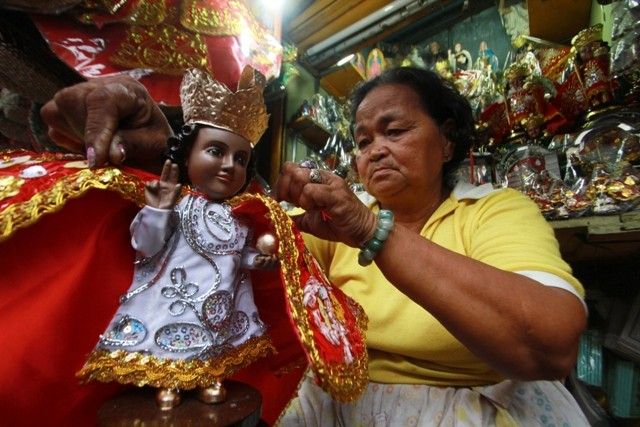The Santo Niño is not a doll

Church reminds devotees
CEBU, Philippines — Images of the Santo Niño have, through the years, evolved in many ways. This year’s Sinulog saw some images dressed in police uniform and even in fabrics bearing famous brands.
Father Ric Anthony Reyes, custodian of the highly-revered religious relic, said the Santo Niño is not a doll that can be dressed any way an owner of an image wants.
“The Augustinian Community, ever since, has been firm on following the traditional vest, which includes the color of the cape and other vestures of the Santo Niño and, until now, we stand firm on the traditional way because the Santo Niño is not a doll that we can let the image wear anything we want,” Reyes said.
He said the clothing of the Santo Niño should "retain a religious sense and propriety," suggesting that devotees should stick to traditional vestments.
“The very reason (of this idea is) that we will not lose sight of the meaning so rich and attached to this and so we encourage them that in vesting their Holy Child images to follow these and not to just lose among the trends of letting the Niño be vested in modern ways,” he said.
Reyes explained that “images should have a capacity to connect, relate and be understood in a universal way with universal effect.”
“For example, what will be your idea of a God if the Santo Niño is wearing a uniform of a police? It loses its religious sense because our image of Jesus is already not universal,” he said.
“In vesting other things on the image is like insisting your type of faith or an interpretation of your own that is not applicable to all. So in short, it is like you own the Santo Niño and you don’t share the image to others,” he continued.
Significantly, the religious image carries symbols with meanings attached to it, he said.
History has it that the image of the Santo Niño was a gift from the Spanish navigators to Queen Juana, the wife of King Humabon, that converted to Christianity, which is believed to arrive first to the country’s shores through Cebu.
Catholic catechism teaches that the wooden image is a concrete representation of the Child Jesus that also reflects child-like virtues like humility, simplicity and obedience.
Despite being depicted a child, the Santo Niño remains to be king and this image is made evident on his vestments and other symbols he wears, Reyes said.
The original image wears a canonical crown and on its body is an inner white garment covered with cape usually in red shade that is embroidered with golden stitches.
“The image reminds us of Jesus being the King, not an earthly king but a divine King, since he is both man and God. And being a King he deserves high respect,” he said.
Reyes said one factor that may have attracted people to the Santo Niño is its kingly image because they see the image as someone superior and whom they can trust.
The image also holds a circular object on his left hand, an orb that symbolizes the earth and the entire universe, he said.
This spherical symbol, he added, reminds people of the sovereignty of the Lord who rules a Kingdom that has no end. On top of the orb is a cross that symbolizes the arrival of Christianity in the islands.
On the image’s right hand, whose fingers form a gesture of blessing, is attached a long scepter, which symbolizes being great, royal or imperial.
The image also wears other symbols like a sash, belt, and the Golden Fleece.
“We cannot strictly say we would not allow vesting the Santo Niño other than what we are encouraging but when it comes to vest him portraying something other than what the real message of the Holy Child in our lives, is not only discouraged but, for me, it should be avoided,” Reyes said. (FREEMAN)
- Latest























